Selecting the best road trips in Spain is a difficult task. There are thousands. To qualify as a “best road trip in Spain” the trip has to have the components that are of particular interest to the traveler.
What’s the appeal…beaches, the regional cuisine of Spain, history, customs and traditions or breathtaking nature?
Granted a country like Spain has all of the above in abundance all over the country., but, if I had to decide, these 4 trips qualify as best road trips in Spain because they capture the essence of the country and contain much of what Spain is famous for. Read on and see if you agree.
The Best Road Trips in Spain
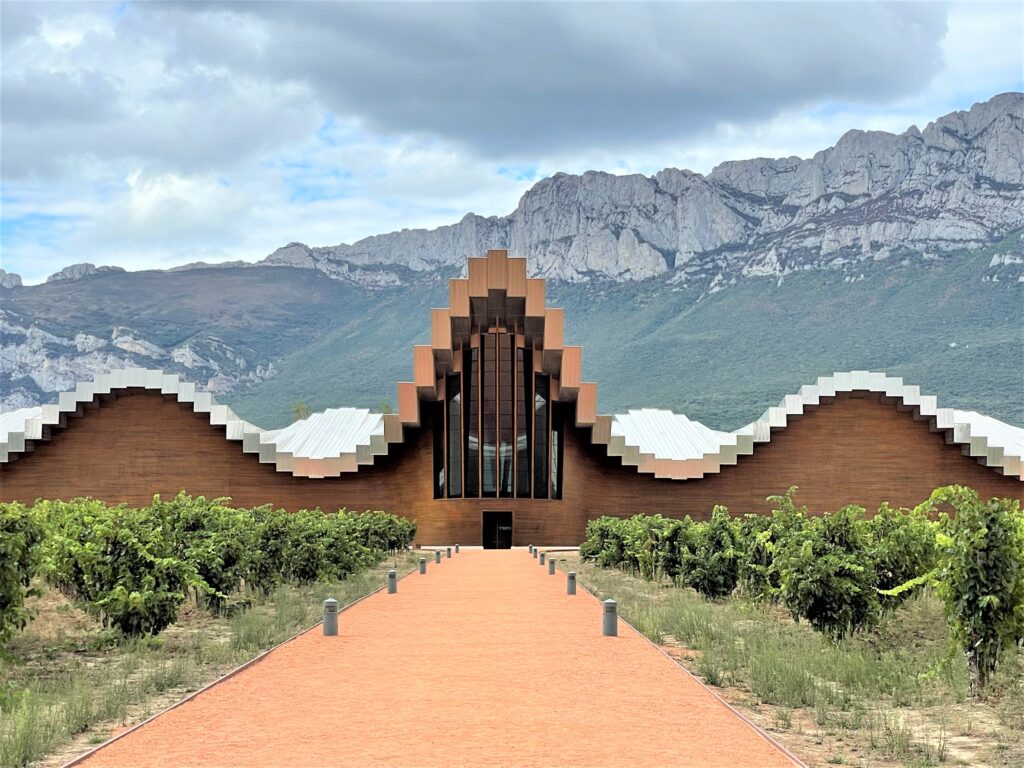
Table of Contents
ToggleNorthern Spain road trip
A northern Spain road trip has it all; picturesque coastal fishing villages, medieval towns, amazing seafood, pristine beaches and lush, green landscapes.
Barcelona
Contrary to most of Spain, this area receives more rain fall earning the moniker of “green Spain.” This road trip from Barcelona to Santiago de Compostela goes through some of Spain’s most beautiful cosmopolitan cities as well as delightful small towns and rugged country side.
Skip the line. Visit Park Guell and La Sagrada Familia
Start in Barcelona, one of Spain’s cultural meccas and visit the architectural masterpieces of home-town-boy-done-good, Antonin Gaudi. These include the unfinished La Sagrada Familia cathedral, Casa Batllo and Mila.
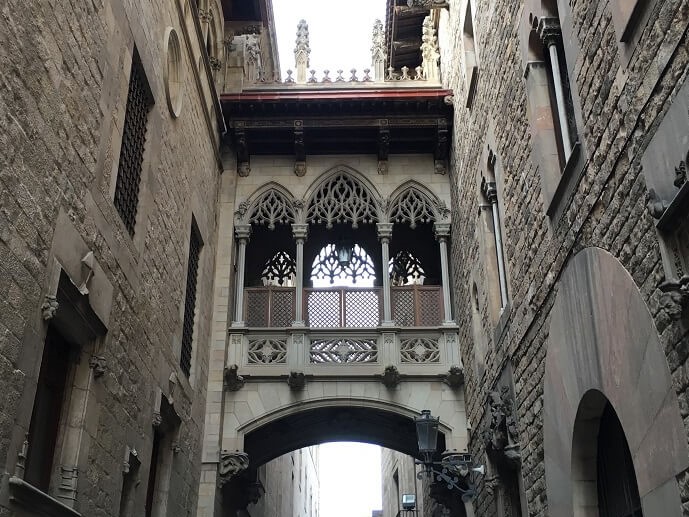
Stroll down Las Ramblas boulevard and make sure to visit the Gothic neighborhood with all its artistic and culinary treasures.
For an outstanding traditional meal in an unparalleled environment, eat at Los Caracoles, in businesses since 1835.
If you want to stay in a fantastical hotel with Daliesque architecture in a great location close to everything you want to see, check out Hotel Casa Fuster on Passeig de Gracia.
Booking.com (function(d, sc, u) { var s = d.createElement(sc), p = d.getElementsByTagName(sc)[0]; s.type = ‘text/javascript’; s.async = true; s.src = u + ‘?v=’ + (+new Date()); p.parentNode.insertBefore(s,p); })(document, ‘script’, ‘//cf.bstatic.com/static/affiliate_base/js/flexiproduct.js’);Logroño and Laguardia
Head northwest to the coast and visit the charming towns of Logroño with its magnificent Baroque church, Santa Maria de La Redonda.
This pretty little town’s main attraction is the tapas crawl on Laurel Street with tapas bars lining both sides of the street.
Twenty minutes north of Logroño is Laguardia one of Spain’s best wine cities. Here is where you sample fine wines in underground cellars.
The best road trips in Spain are those that involve fine Spanish wine and tapas.
Where to stay in Logroño and Laguardia.
Bilbao
Once a struggling industrial town, Bilbao is now a cultural powerhouse, home to the Guggenheim Museum. Bilbao is also where you’ll find La Ribera, the biggest market in Spain. Make sure to grab a meal in one of the market’s dining rooms.
Where to sty in Bilbao.
Oviedo
Home to many UNESCO World Heritage sites including several churches and royal palaces dating from the 9th century CE, Oviedo is the capital of the Asturias region.
Asturias is the only region of the country that was never conquered by the Moors so is considered the cradle of modern-day Spain.
It was from Asturias that King Pelayo forced the Moors to retreat at the Battle of Covadonga in 718CE. The Moors were finally expelled from Spain by Queen Isabela and King Ferdinand in 1492.
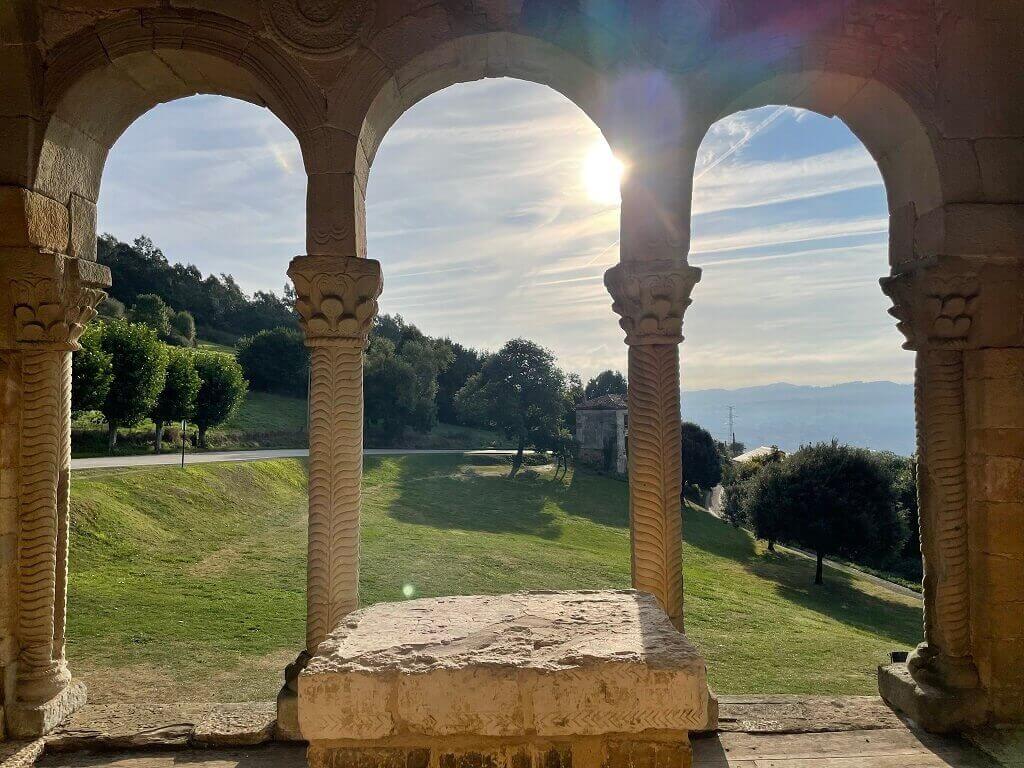
Oviedo is a marvelously livable city with world-class museums, lush parks, pedestrianized streets, amazing architecture and a delicious regional cuisine.
One interesting custom is found throughout the city. The local beverage, an alcoholic cider is served from up to three feet in the air in order to aerate it. It’s fun to see the waiters pour it without missing a drop!
Where to stay in Oviedo.
Read Next: Hidden Gems in Spain off-the-beaten-track
A Coruña
This ancient port city is home to the Tower of Hercules, a lighthouse built by the Romans in the 1st century CE.
Just as impressive is the Maria Pita Plaza, a broad square surrounded by graceful buildings.
Seafood is the city specialty as the town is almost entirely surrounded by water. The finer restaurants are near the docks.
Try the local specialty, polpo a la feira, Galician octopus. Wash it down with the area’s signature wine, a white albariño from the Rias Baixas wine region further south.
Where to stay in A Coruña.
Santiago de Compostela
The most well-known part of Galicia and final destination of the Camino de Santiago or Saint James Way pilgrimage, Santiago’s Old Town, is itself a UNESCO World Heritage site.
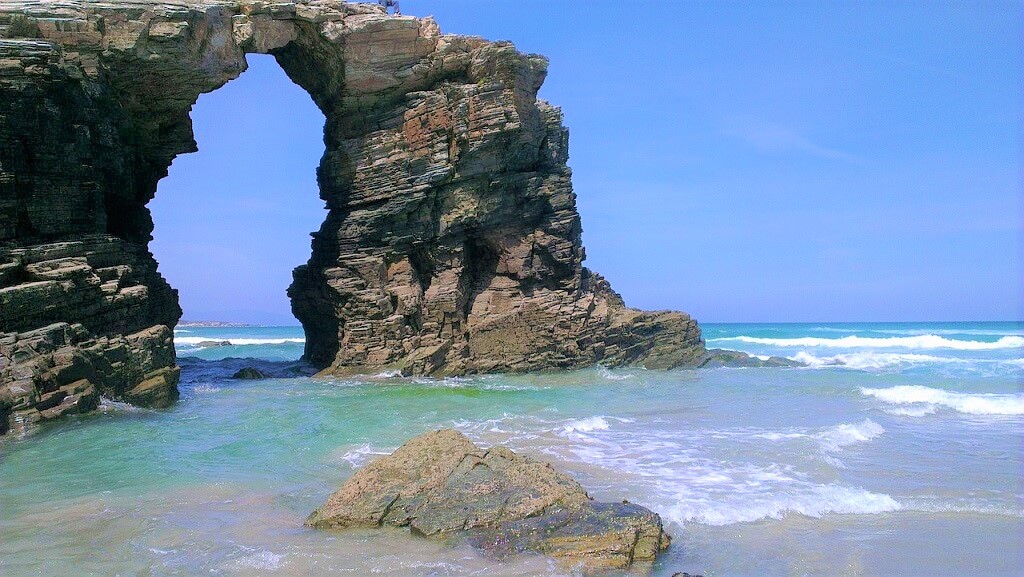
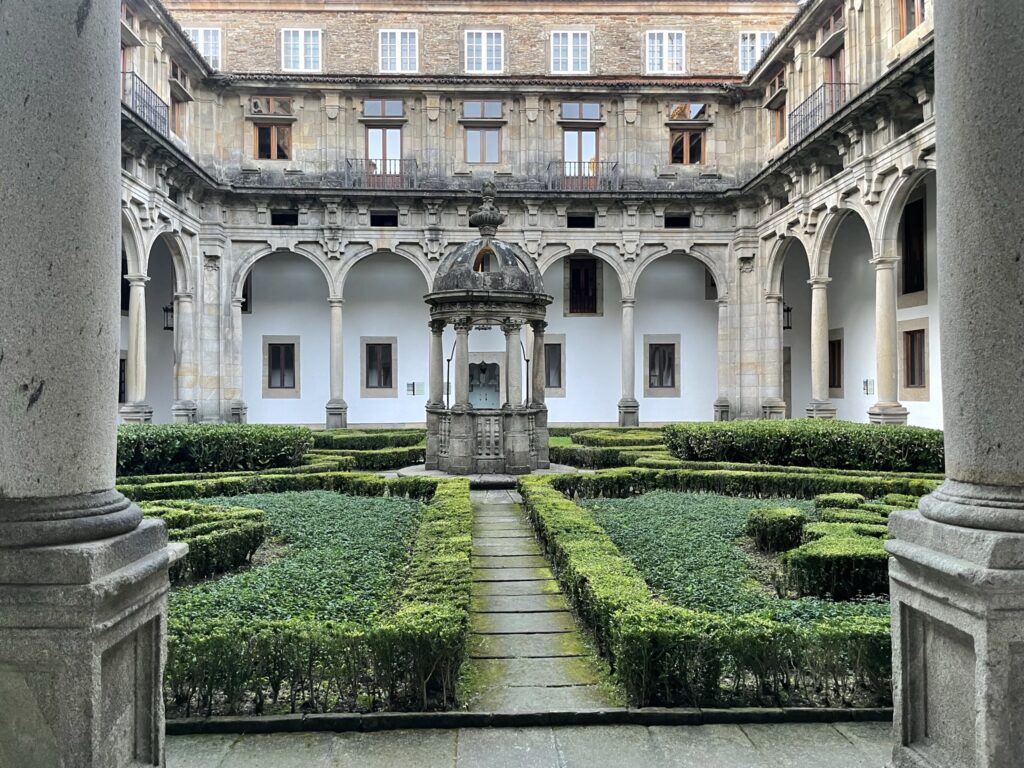

Obradorio Plaza with its magnificently brooding cathedral is the official end of the pilgrimage. Here is where legend says the remains of the Christian apostle, Saint James are buried.
The Parador de Los Reys Catolicos on Obradorio Plaza is an ideal place to stay. A parador is a government-run, refurbished structure like monasteries, convents, abbeys, palaces turned into hotels.
It is worth staying in a parador due to the beauty of the structure, the location and the historical significance.
The Parador de Los Reyes Catolicos or Parador of the Catholic Monarchs is a refurbished hospital that Queen Isabel and King Fernand founded to help pilgrims on the Camino.
Southern Spain road trip
On a southern Spain road trip you will note that the weather is much dryer and hotter than in the north. But it is no less fascinating. Here is where you see the Moorish influence in the area’s architecture, food and the names of towns. Some of the most beautiful Spanish palaces and castles are found in the south.
Southern Spain offers everything you could want to create one of the great road trips in Spain.
Madrid
A good place to start your southern Spain road trip is in Madrid. Explore this exciting city and head south.
An often quoted saying is “From Madrid to heaven.” That’s how many Madrileños feel about their city.
Madrid is the capital of Spain and its cultural center with three of the world’s most important museums; The Prado, the Reina Sofia and the Thyssen-Bornemisza.
Slkp the line. The Prado and the Thyssen-Bornemisza
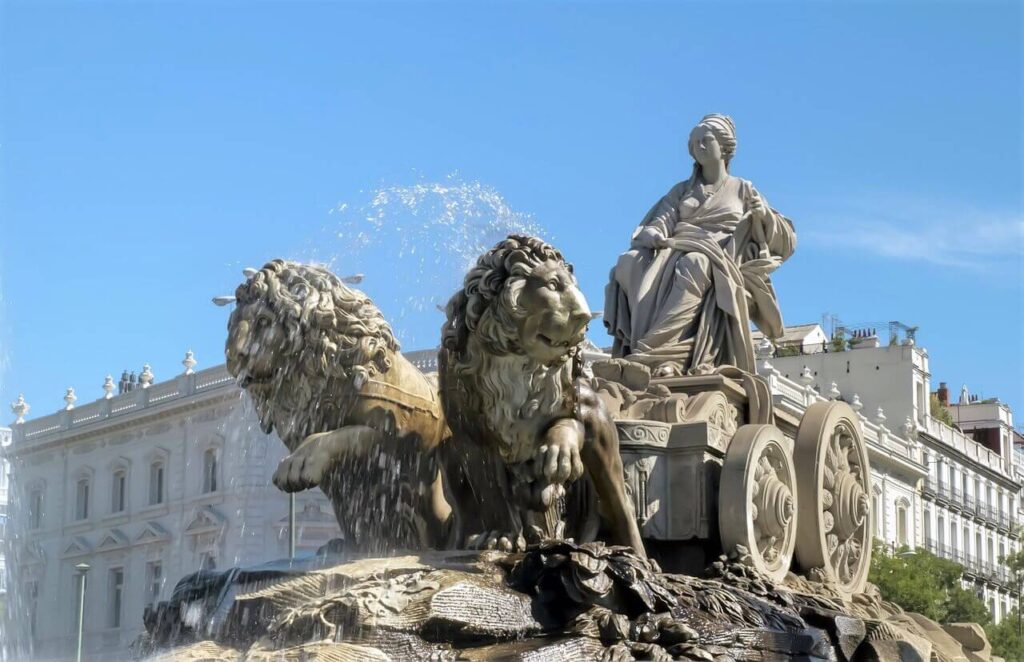
Madrid’s neighborhoods are fun to explore. The expansive Parque El Retiro park offers a welcome respite from the bustle of the city and the restaurants are, of course, legendary.
One famous restaurant, El Botin, is one of the oldest continuously operating eateries in the world, and was a Hemingway favorite. It is right next to Plaza Mayor, the city’s historic main square.
Where to stay in Madrid? The Westin Palace Hotel is near Madrid’s spectacular museums like the Prado and close to everything you want to see in Madrid. Plus, it’s reasonably priced for what they offer.
Booking.com (function(d, sc, u) { var s = d.createElement(sc), p = d.getElementsByTagName(sc)[0]; s.type = ‘text/javascript’; s.async = true; s.src = u + ‘?v=’ + (+new Date()); p.parentNode.insertBefore(s,p); })(document, ‘script’, ‘//cf.bstatic.com/static/affiliate_base/js/flexiproduct.js’);Ronda
On the way from Madrid to Spain’s southern coast is the unmissable town of Ronda.
Ronda is small. You can see it in half a day. Still, it is the third most visited city in southern Spain.
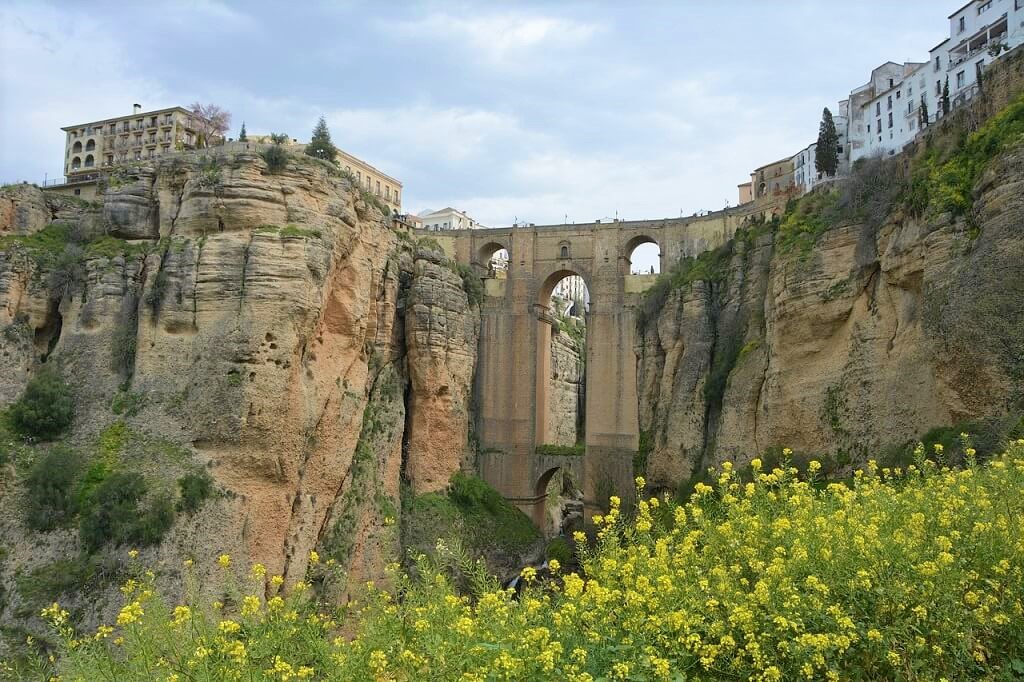
The first thing that will impress you is the sight of the Puente Nuevo. It was completed in 1793 to improve on two existing bridges, one build by the Romans.
Where to stay in Ronda.
Malaga
Glorious, coastal Malaga on Spain’s sun coast has an impressive history. The Roman amphitheater is next to the Moorish Alcazaba, or castle, which is near the Renaissance cathedral.
Just walking around Malaga is like strolling around a living museum.
Nighttime in Malaga’s Old Town is packed with people seeking out the perfect Spanish dinner or tapas crawl in the many restaurants that line the main street and spill out into the little side streets.
Where to stay in Malaga
Cartagena
Another ancient port city, Cartagena’s history dates back to 220 BCE when it was founded by the Carthaginians.
Today the city is a rich mosaic of Muslims, Spaniards, some Africans and the occasional Western pensioner.
Once a major port in the Roman world, the city boasts many beautifully preserved Roman ruins including its 1st century amphitheater.
Don’t miss the Casa de La Fortuna, once a Roman villa for the wealthiest of the town’s citizens.
Where to stay in Cartagena
Alicante
Alicante was my favorite city on this Spanish road trip. I didn’t know what to expect because I didn’t really know much about the city.
What I found were wide, palm fringed avenues, gorgeous architecture, excellent restaurants, state of the art interactive museums, vibrant nightlife and friendly people. Yes, you can find that anywhere in Spain. But Alicante had a special vibe.
In Alicante we discovered a little aparthotel off a side street. It was one of those little gems you hope to find that make the trip.
The Odyssey Rooms were brand new, great breakfast, it has a can’t-beat location and lovely interior.

Valencia
The quintessential city of contrasts, Valencia lives in the medieval world as well as the ultra-modern.
The picture-perfect Old Town is full of medieval and renaissance structures like the Valencia Cathedral and the Silk Exchange (get the free audio guide).
Don’t miss the Central market, but make sure you know the opening and closing times as they close early.
This is also a city of museums. My favorite was the so-called Museum of Ceramics which has very little to do with ceramics. It is, instead, a faithful representation of the former home of a minor Spanish royal, the Marques de Dos Aguas.
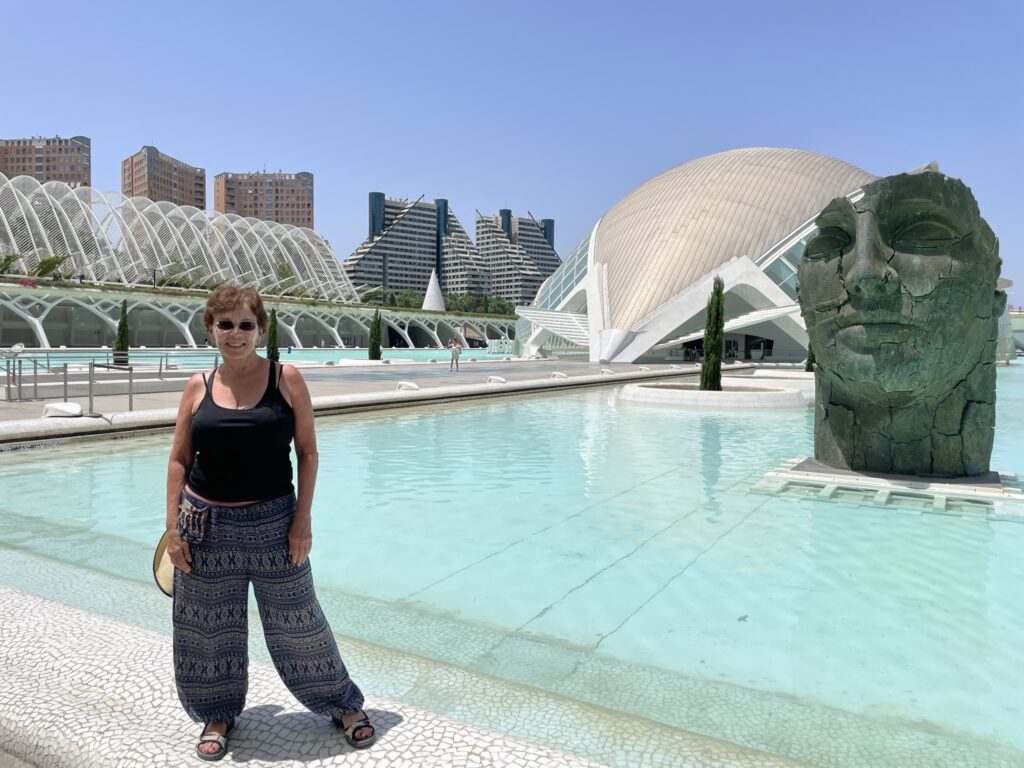
The house is lavishly decorated and gives you an idea of how the very wealthy lived not so long ago.
Step out of the Old World into the magnificent, new City of Arts and Sciences. It is a collection of several performance venues, museums, parks and convention centers on the outskirts of the city.
You’ll need to spend at least a day here to do it justice.
Where to stay in Valencia.
Western Spain road trip – Extremadura
This western road trip takes place in the far-west region of Extremadura just three hours west of Madrid. The region is perfect for off-the-beaten-track Spanish adventures especially due to the region’s connection to the Spanish conquistadores and the Roman Empire.
Extremadura is not as well-known as other parts of Spain but it easily has the necessary ingredients to create one of the most interesting road trips in Spain.
Caceres
Caceres is the capital of the Extremadura region. It is the ideal location to base yourself in order to visit the most important highlights of he region.
The Old Town of Caceres is often considered one of the most beautiful in Spain and is a UNESCO World Heritage site.
Many of the conquistadores who journeyed to the New World came from this hot and dry region; Francisco and Hernando Pizarro, Hernan Cortes, Ines Suarez and Vasco Nuñez de Balboa among others.
One of the most impressive buildings in the Old Town was built by a great-grandson of Moctezuma himself!
Other can’t-miss sights in Caceres include the Caceres Museum and Plaza Mayor.
Caceres is a foodie heaven. The area specializes in hams, cheese and olive oil. But perhaps the top experience in Caceres besides wandering the Old Town is having a meal at the 2-star Michelin eatery, Atrio Restaurant.
The recently renovated Parador de Caceres is definitely the best place to stay in town. This historic palace bills itself as a “walk through history from the Romans to the Middle Ages. A parador is a government-run restored historic structure.
Merida
Merida was the ancient capital of the Roman province of Lusitania. Founded in 25 CE when Rome was at the height of its Imperial power.
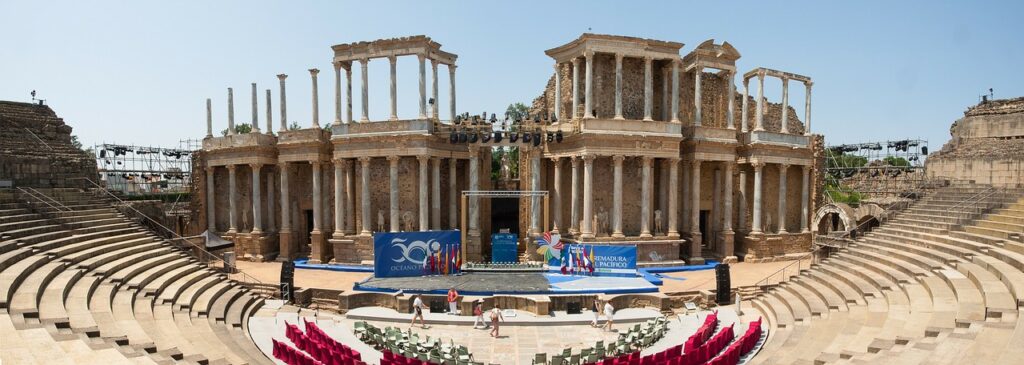
I have never seen such a large collection of beautifully preserved Roman ruins as I’ve seen in Merida; temples, amphitheaters, forums, bridges. The legacy of Imperial Rome is everywhere in Merida.
The city is generally considered to have the best Roman ruins in Spain.
Make sure to visit the National Museum of Roman Art to help explain the marvels you’ll see in this gem of a town.
One of Spain’s first paradores in its extensive collection, the Parador de Merida is a renovated convent in the Baroque style. The ancient cloisters have been transformed into a sunny outdoor restaurant.
Don’t miss the period antiques around the property.
Perhaps the highlight of your stay will be a meal in the parador’s restaurant that specializes in local traditional Spanish cuisine.
Guadalupe
Paradores, the government-run renovated historic structures operating as hotels are found all over Spain. However, the one in Guadalupe is simply extraordinary.
It is a restored monastery, the Monasterio de Santa Maria de Guadalupe, and a UNESCO World Heritage site.
How many hotels do you know of that are UNESCO World Heritage sites?
The legend is that some priests found a statue of the Virgin Mary in the vicinity and decided to build a monastery on the same spot.
The town of Guadalupe itself is worth exploring but the parador…ah…the parador!
Trujillo
Trujillo is the hometown of most of the conquistadores that journeyed to the New World. The main square has structures built by Pizzaro and statues commemorating the voyages. The town is worth a stop if only for the historical significance.
Where to stay in Trujillo.
Alcantara
About one hour northwest of Caceres near the border between Spain and Portugal is the little town of Alcantara.
This bucolic little town was in different centuries, a Roman outpost, a Moorish city and a Visigoth settlement before being definitively conquered by the Christians.
The town houses what was once a convent but is now a foundation and the last headquarters of the military order of the knights of Alcantara.
It has a lovely Renaissance façade and a Gothic style cloister worthy of a church in any European capital.
By far the most impressive feature of this sleepy little town is the “Roman Bridge of Alcantara.”
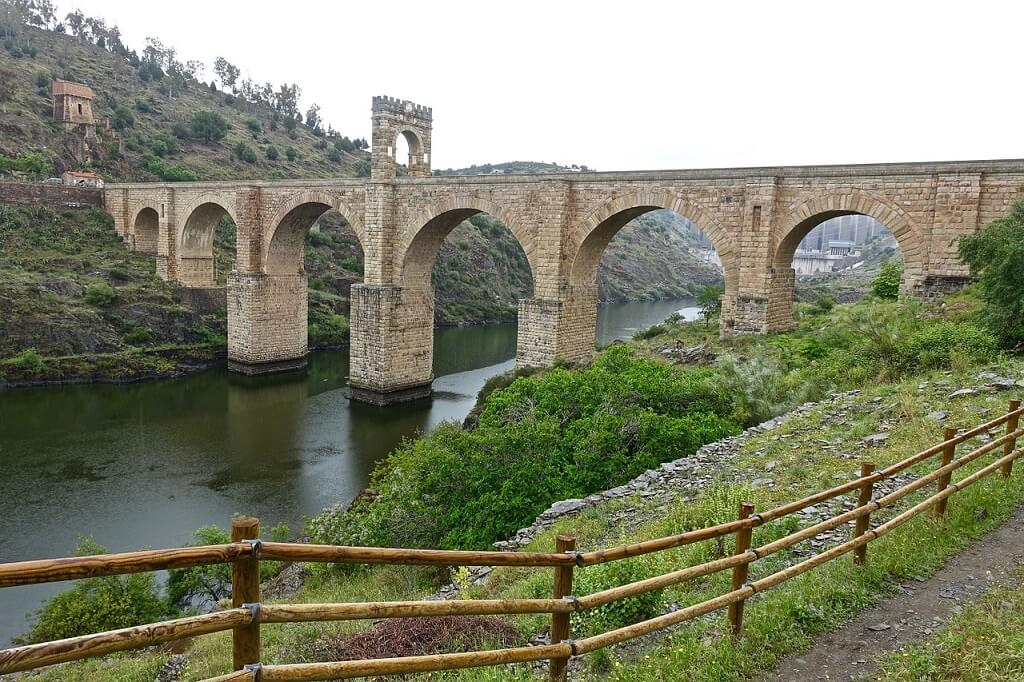
Built by the Roman architect, Caius Julius Lacer in 107 CE, this remarkable masterpiesce of architecture and engineering features beautiful symmetry and graceful arches.
It’s difficult to imagine that this bridge was built over 2000 years ago and is still doing its job carrying people and goods to and fro.
I walked across the bridge admiring its structure and imagining what the bridge’s architect must have been thinking as he created such a magnificent feat of engineering.
As I turned away to leave I saw a plaque on the bridge that said. “Pontem perpetui mansurum in saecula” (I have built a bridge which will last forever).
The architect knew that 2000 years after he completed this bridge someone would come across it and be amazed.
It felt almost as if we had somehow communicated across the centuries. Silly, I know. But these are the moments you travel for.

Pontevedra, Galicia road trip
Anywhere is a good place to start your Spanish road trip in the province of Pontevedra. Everything is so close to each other in this small road trip in Spain that you can reach any road trip highlight within an hour.
Vigo
The costal fishing town of Vigo is the busiest and most important post in Spain. With a population of over 300,000 it is the most populous city in the Pontevedra province.
Although mainly a busy industrial fishing center, the city has beautiful beaches, a bustling center city and excellent seafood restaurants. The sushi, in particular, is so good it would make a Tokyo chef blush.
Vigo is also a great departure point from which to visit the Cies Islands and the nearby protected islands of Galicia’s National Park.
Where to stay in Vigo.
Baiona
On March 15, 1493 the last remaining ship on Columbus’s first voyage, The Pinta, limped into the port of Baiona. This marked the beginning of the age of exploration.
A replica of the ship complete with wax personnel depicting Spanish sailors, indigenous Americans and chests laden with golden treasures from the New World.
Every year the town marks this event with a celebration called La Fiesta de la Arribada or Feast of the Arrival. The normally quiet town swells with tourists from all over.
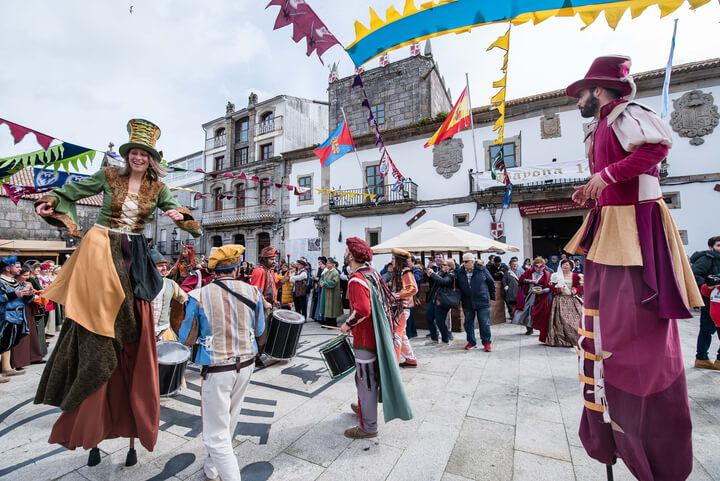
For a small town, Baiona punches way above its weight with medieval streets, excellent restaurants – try Taberna Mendoza – and lovely hiking trails.
Perhaps the major draw is the Parador de Baiona, a government-operated hotel reconstructed from a medieval palace. The parador sits broodingly on a promontory facing the wild Atlantic Ocean on three sides. What a view!
The period furniture and decorations are designed to harken back to an age of medieval and Renaissance splendor. The views are breathtaking.
The restaurant in the parador specializes in local regional cuisine and seafood.
Don’t forget to stop at the local Tourism Office for tips on how to best enjoy this remarkable little town.
Pontevedra
Pontevedra is the capital of the eponymous province. This ancient, elegant city is known for its many pedestrian streets lined with restaurants and trendy shops.
The symbol of the city is the unusual round-shaped church of the Pilgrim Virgin built in 1778 in the Baroque style. The city also has fine museums.
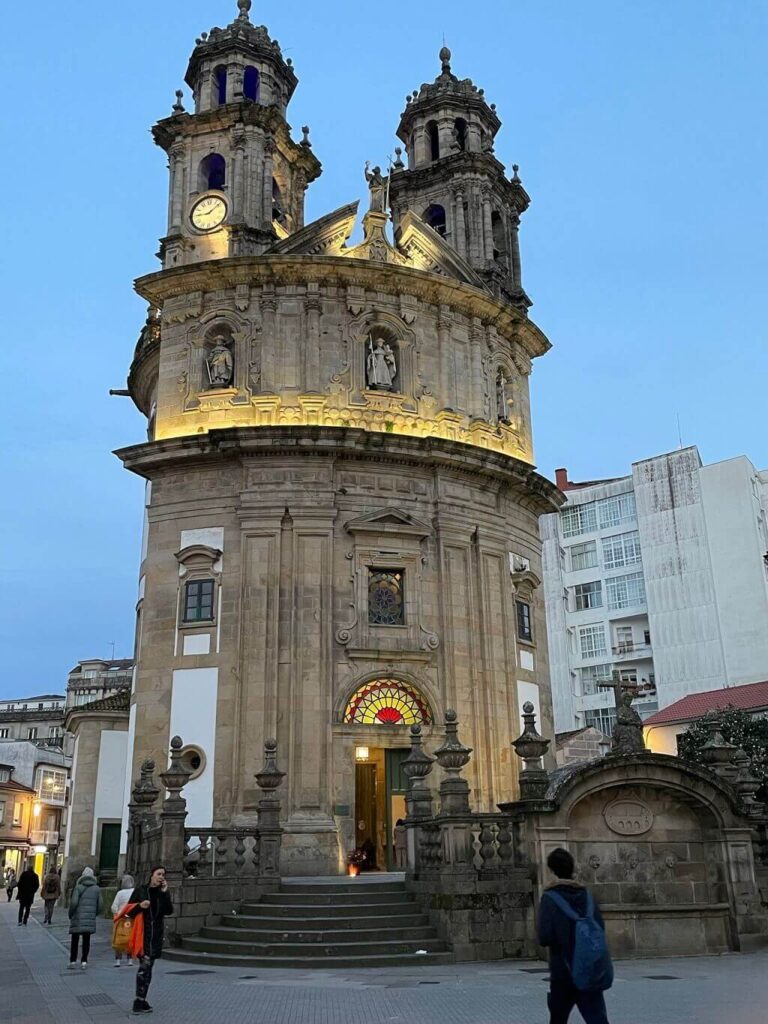
Make sure to check opening times – many interesting attractions are closed on Sundays and Mondays.
The most exciting place to stay in Pontevedra is the Parador de Pontevedra, one of the government-owned renovated historic structures converted into luxury hotels.
This stunning hotel is located in the city’s Old Town. It is a renaissance structure from the 16th century that was the former residence of the Counts of Maceda.
The hotel is decorated in period furniture and antiques, and features a splendid interior garden.
The Parador de Pontevedra is not open n the winter time so it is important to check seasonality before booking.
Rias Baixas wine region
The Rias Baixas wine region of Galicia, Spain is one of the finest of the European wine regions and until recently among the lesser known.
Rias Baixas is home to the dry, crisp, white albariño wine which has become one of the world’s most popular and highly-regarded.
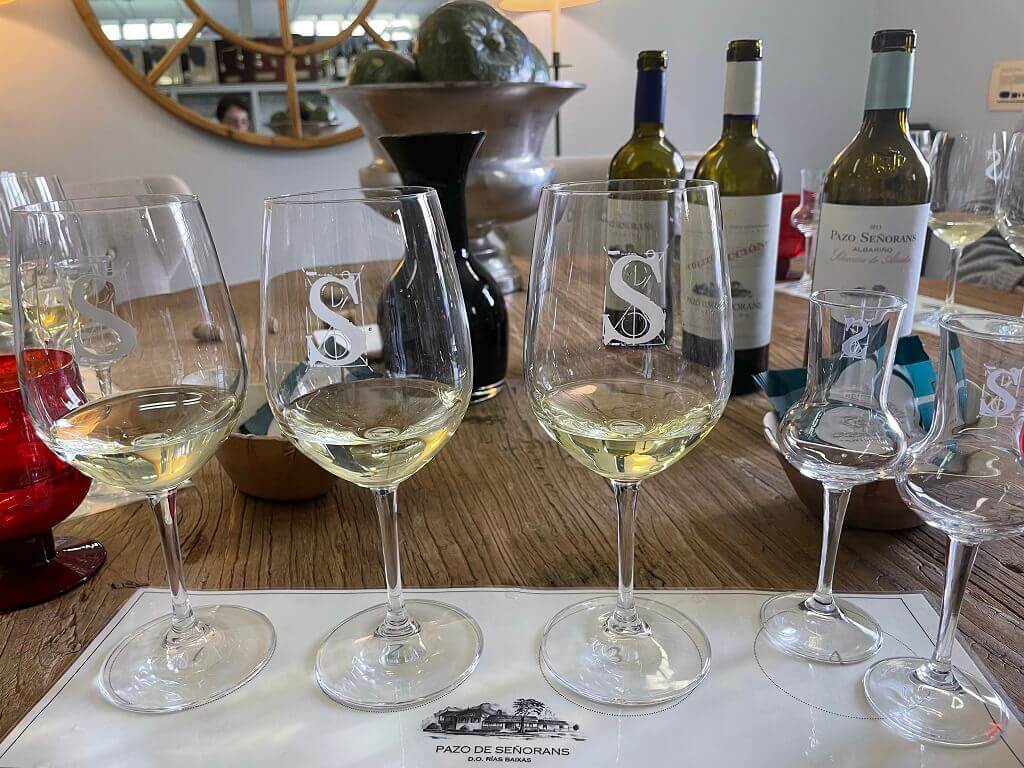
One of the best Spanish road trips you can create is to wander the Rias Baixas wineries sampling the regions wines, tasting the regional cuisine and exploring the vineyards.
The best time to go on a Spanish road trip
There is never a bad time to explore Spain and embark on a Spanish road trip but the best time is the fall and the spring. The weather is cooler during these times. Many attractions are closed in the winter season.
The summer season brings the heat, the higher prices and the crowds of tourists.
Renting a car in Spain for the best road trips in Spain
Renting a car in Spain is pretty straightforward. In order to rent a car for your road trips in Spain, you’ll need to present:
- A valid driver’s license from your own country.
- Additional ID like a passport.
- A credit card in the name of the person renting the car.
You’ll need liability insurance to rent a car. This is typically included in the price of the rental. You will be asked if you wish to include additional insurance like collision damage or theft but that won’t be mandatory. You may want to consider this additional insurance.
Check with your credit card provider to see if its insurance policy covers car rental insurance.
Fortunately, conditions on Spain’s roads, called autopistas, are good to excellent so driving on them is easy and pleasant.
The speed limit in Spain is 80 to 100km. Tolls on the autopista range from 5 to 30 Euros depending on distance. Use a navigation or map app whenever possible. A local SIM card will provide data for navigating just like at home.
Rental car Travel Tips:
I recommend Discover cars because of their convenient locations, reliable information, variety of cars and reasonable prices. This is your best partner for your road trips in Spain.
It is cheaper to rent a car in Europe during the off season.
When renting a car in Europe, smaller is better. Driving in the towns, especially in the Old Towns can be challenging. Streets are narrow and signage can be confusion.
Avoid bringing cars into Old Towns or city centers. Either park outside and walk or take public transportation. Another option is to park in underground parking lots in city centers. Avoid parking in the streets.
A stick shift car is significantly cheaper and more common than an automatic. In many cases, an automatic won’t be an option at all.
Many gas stations are full service. Tipping the attendant is not customary. Cash or credit are both accepted.
NB: Wherever you go, don’t forget travel insurance.
Want to know more about this fascinating region and road trips in Spain? Check out these reference materials.
What are your thoughts on these road trips in Spain? Which is your favorite? Which one did we miss? Let us know in the comments.
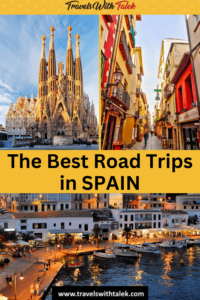

BTW, if you are getting ready for your trip, make sure to take advantage of these useful, money-saving links to book your trip:
- Research and book your flight with Skyscanner. I have found them to be the best because they list all airlines including the budget ones. You are always sure of having researched all options.
- For car rental around the world, Discover Cars has flexible pickup and drop-off options, I recommend Discover Cars.
- Book your accommodation with Booking.com. I find they have a wide selection and a nice, user-friendly, transparent website.
- Protect your trip and, more importantly, protect yourself with travel insurance. I use Travelinsurance.com and have been very happy with them.
- For more general tours to any destination or attraction, book with Viator. Check them out.
- Need a visa? Get your visa for all countries with Passport Visa Express.
- Looking for a cool walking tour to explore a city? My favorite walking tours are offered by Take Walks.
- Food and drink tours are the best way to enjoy a city. And Devour Tours are my favorite.
- Looking for a good VPN to protect your security, privacy and freedom online while traveling? Nordvpn is your best option.
- The best and most economical way to stay connected while traveling is with an Airalo eSIM.
I personally use, and can recommend, all the companies listed here and elsewhere on my blog. By booking through these sites, the small commission we earn – at no cost to you – helps us maintain this site so we can continue to offer our readers valuable travel tips and advice.






















